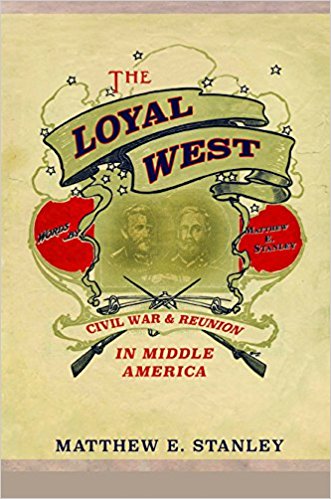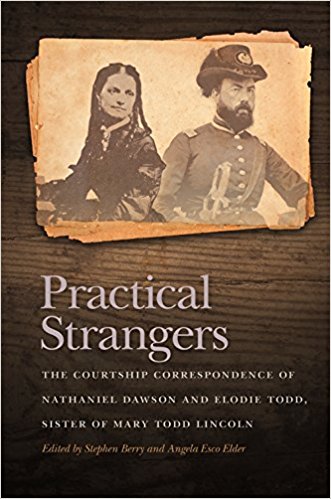The Loyal West: Civil War and Reunion in Middle America by Matthew E. Stanley. University of Illinois Press, 2016. Paper, ISBN: 978-0252082245. $24.95.
 During the Grand Review of Union Armies at the close of the American Civil War, newspaper reports celebrated the achievements of the returning veterans. The Boys in Blue were lauded for their efforts in preserving the Union, but as Eastern and Western soldiers met for the first time in the nation’s capital, it became clear that little more than uniforms united the men. Soldiers of the Western armies often observed—after being in close proximity with their Eastern counterparts—that Western men held fundamentally different beliefs about the war and its meaning than their Eastern compatriots. Sectional division not only separated North and South, but they also marked the difference between East and West. It is this internal division that Matthew E. Stanley deftly examines in The Loyal West: Civil War and Reunion in Middle America.
During the Grand Review of Union Armies at the close of the American Civil War, newspaper reports celebrated the achievements of the returning veterans. The Boys in Blue were lauded for their efforts in preserving the Union, but as Eastern and Western soldiers met for the first time in the nation’s capital, it became clear that little more than uniforms united the men. Soldiers of the Western armies often observed—after being in close proximity with their Eastern counterparts—that Western men held fundamentally different beliefs about the war and its meaning than their Eastern compatriots. Sectional division not only separated North and South, but they also marked the difference between East and West. It is this internal division that Matthew E. Stanley deftly examines in The Loyal West: Civil War and Reunion in Middle America.
Geographically, Stanley is concerned with the Ohio River Valley—the states of Illinois, Indiana, and Ohio, as well as their southern neighbor, Kentucky. It was in this region, Stanley argues, where settlers from North and South met and divided, creating enclaves of sympathy for the slaveholding South, Democrats of the Stephen A. Douglas stripe (and later Copperheads), as well as free labor Republicans who were unsympathetic to the party’s radicalism. It was a region of intense political feeling—home to three of the four candidates in the 1860 presidential election—and a place where abolitionism never seized the political imagination. As a result, Stanley shows, the political feeling that came to dominate the region during the Civil War and in the years following was “a broad strain of conservative Unionism,” typified by Douglas’s assertion that neutrality in the war was equivalent with treason, that supported “the use of force to preserve the Union” while opposing “specific policies of the Lincoln administration” (43, 48).
Stanley’s arguments about the wartime experiences of Ohio, Illinois, and Indiana add support to the claims made by Gary W. Gallagher in The Union War, identifying an intense strain of Unionism that persisted throughout the war and was largely unaccepting of emancipation as a war aim. Stanley defines this Western Unionism as “antiblack, anti-eastern, and anti-Confederate” (86). This meant that in the Ohio River Valley, most citizens eventually accepted emancipation as a means to achieve victory, but never as a stand-alone goal of the war. This belief represented a repudiation of what many Middle Westerners saw as a national shift away from the traditional Jacksonian-era power alliances of the West and South to an embrace of the liberal, urban, and capitalist East.
One of the most innovative arguments in Stanley’s monograph is the contention that Reconstruction was doomed to fail because Middle Westerners did not support the national program of reunification. Stanley shows that many Middle Westerners rejected the precepts of the Fifteenth Amendment, as long-held beliefs in white supremacy and conservative political economy reacted against the expanding power of the federal government. Economic recession in 1873 and increased competition for jobs between poor whites and newly freed blacks led to extralegal violence and the emergence of Jim Crow laws. In order to succeed, Reconstruction needed to be accepted in the Middle West, Stanley argues, because the region was a bellwether for the nation in its rejection of radicalism and deeply entrenched racism. If the Middle West could not be reconstructed, there was little hope for the states of the former Confederacy.
Stanley closes his monograph by introducing regionalism into longstanding scholarly debates over Civil War memorialization and reconciliation. Stanley’s claim is that the existence of conservative Unionism in the Ohio River Valley during the Civil War led veterans to emphasize the Union Cause in their memorialization of the conflict—and vehemently reject the Lost Cause. Stanley also suggests that because of the Middle West’s status as a border region, reconciliation there occurred earlier than scholars such as Caroline E. Janney or John R. Neff have recognized.
Stanley’s book is a perceptive study of a region that contributed significantly to the Civil War. Charts showing county level returns for the presidential elections of 1860-1876 accompany a readable and well-illustrated text. The Loyal West: Civil War and Reunion in Middle America provides an admirable model for future studies of regional identity in the Civil War era, and should be commended for its willingness to expose and examine the complexities of a region that was not always a bastion of progressivism. Readers with an interest in Civil War memory or regionalism’s effect on the conflict will find this work well worth adding to their libraries.
Cecily Zander is a Ph.D. student in the Department of History at The Pennsylvania State University.




